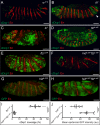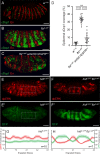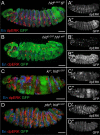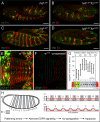EGFR signaling coordinates patterning with cell survival during Drosophila epidermal development
- PMID: 30379844
- PMCID: PMC6231689
- DOI: 10.1371/journal.pbio.3000027
EGFR signaling coordinates patterning with cell survival during Drosophila epidermal development
Abstract
Extensive apoptosis is often seen in patterning mutants, suggesting that tissues can detect and eliminate potentially harmful mis-specified cells. Here, we show that the pattern of apoptosis in the embryonic epidermis of Drosophila is not a response to fate mis-specification but can instead be explained by the limiting availability of prosurvival signaling molecules released from locations determined by patterning information. In wild-type embryos, the segmentation cascade elicits the segmental production of several epidermal growth factor receptor (EGFR) ligands, including the transforming growth factor Spitz (TGFα), and the neuregulin, Vein. This leads to an undulating pattern of signaling activity, which prevents expression of the proapoptotic gene head involution defective (hid) throughout the epidermis. In segmentation mutants, where specific peaks of EGFR ligands fail to form, gaps in signaling activity appear, leading to coincident hid up-regulation and subsequent cell death. These data provide a mechanistic understanding of how cell survival, and thus appropriate tissue size, is made contingent on correct patterning.
Conflict of interest statement
The authors declare that they have no competing interests
Figures




References
Publication types
MeSH terms
Substances
Grants and funding
LinkOut - more resources
Full Text Sources
Other Literature Sources
Molecular Biology Databases
Research Materials
Miscellaneous

